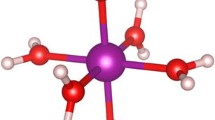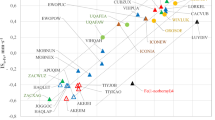Abstract
The electronic structures of Fe3+ coordination sites in hematite and maghemite are obtained from self-consistent field Xα scattered-wave (SCF-Xα-SW) molecular orbital calculations on an octahedral (FeO6)9− cluster, a trigonally distorted (FeO6)9− cluster, and a tetrahedral (FeO4)5− cluster. The electronic structures of these coordination sites should also give a good description of those of Fe3+ cations in other oxides and silicates. The overlapping sphere approach to the SCF-Xα-SW formalism is used and is found to give more accurate results than previous calculations on these systems.
Multiplet theory is used to relate the one-electron molecular orbital energies to the ligand field spectra of Fe3+ in oxides. Calculated energies of ligand to metal charge transfer transitions agree with experimental data and are used to interpret the near-UV spectra of Fe3+ oxides and silicates.
The calculated wavefunctions show that chemical bonds in Fe3+ oxides are fairly covalent. Moreover, the Fe-O bond has a strong spin polarization. The spin dependance of the covalency explains how superexchange and the main features of the magnetic structures of iron oxides are predicted from simple (FeO6)9− and (FeO4)5− cluster calculations.
Similar content being viewed by others
References
Blake RL, Hessevick RE, Zoltai T, Finger LW (1966) Refinement of the hematite structure. Am Mineral 51:123–129
Blazey KW (1977) Optical absorption of MgO:Fe. J Phys Chem Solids 38:671–675
Byrom E, Freeman AJ, Ellis DE (1975) Covalency effects on tetrahedral and octahedral Fe3+ sites in YIG: charge and spin densities and neutron form factors, AIP Conference Proceedings 24, Magnetism and Magnetic Materials 1974:209–210
Cheng JC, Kemp JC (1971) Magneto-optical study of the spinlattice relaxation of Fe3+ in MgO. Phys Rev B4:2841–2846
Dickof PA, Schurer PJ, Morrish AH (1980) Magnetic structure of zinc substituted magnetite at 4.2 K. Phys Rev B22:115–127
Faye GH (1969) The optical absorption spectrum of tetrahedrally coordinated Fe3+ in orthoclase. Can Mineral 10:112–117
Fasiska EJ (1967) Structural aspects of the oxides and oxyhydrates of iron. Corros Sci 7:833–839
Ferguson J, Guggenheim HJ, Tanabe Y (1966) The effects of exchange interactions in the spectra of octahedral manganese II compounds. J Phys Soc Jap 21:347–354
Ferguson J, Fielding PE (1972) The origins of the colours of natural yellow, blue and green sapphires. Aust J Chem 25:1371–1385
Gibb TC (1976) Principles of Mossbauer spectroscopy. Chapman and Hill, London
Goodman BA (1982) Mossbauer spectroscopy. In: Fripiat JJ (ed) Advanced techniques for clay mineral analysis. Elsevier, Amsterdam, pp 113–137
Johnson KH (1973) Scattered wave theory of the chemical bond. Adv Quantum Chem 7:143–185
Johnson KH, Smith FC (1972) Chemical bonding of a molecular transition metal ion in a crystalline environment. Phys Rev B1:831–843
Karickhoff SW, Bailey GW (1973) Optical absorption spectra of clay minerals. Clays Clay Miner 21:59–70
Krebs JJ, Maisch WG (1971) Exchange effects in the optical absorption spectra of Fe3+ in Al2O3. Phys Rev B4:757–769
Lehmann G (1970) Ligand field and charge-transfer spectra in Fe (III)-O Complexes. Z Phys Chem NF 72:279–297
Lehmann G, Harder H (1970) Optical spectra of di- and trivalent iron in corundum. Am Mineral 55:98–105
Lever ABP (1968) Inorganic Electronic Spectroscopy. Elsevier, Amsterdam
Lohr LL (1972) Spin-forbidden electronic excitations in transition metal complexes. Coord Chem Rev 8:241–259
Manning PG (1970) Racah parameters and their relationships to lengths and covalencies of Mn2+ and Fe3+ oxygen bonds in silicates. Can Mineral 10:677–687
Mao HK, Bell PM (1974) Crystal field effects of ferric iron in goethite and leidocrocite: Band assignments and geochemical application high pressure. Carnegie Inst Washington, Yearb 1973:502–507
Maruthe VR, Trautwein A (1983) Calculation of charge density, electric field gradient and internal magnetic field at the nuclear site using molecular orbital cluster theory. In: Thosar BV (ed) Advances in Mossbauer Spectroscopy, pp 398–449
Marusak LA, Messier R, White WB (1980) Optical absorption spectrum of hematite, α-Fe2O3, near IR to near UV. J Phys Chem Solids 41:981–984
Norman JG (1976) Non-empirical versus empirical choices for overlapping sphere radii ratios in SCF-X α -SW calculations on ClO4- and SO2. Mol Phys 31:1191–1198
Rossman GR (1975) Spectroscopic and magnetic studies of ferric iron hydroxy sulphates: intensification of color in ferric iron clusters bridged by a single hydroxide ion. Am Mineral 60:698–704
Salahub DR, Messmer RP, Johnson KH (1976) Ionization potentials and bond lengths for CO, N2 and F2 using the SCF-X α- SW: a study of the effect of overlapping spheres. Mol Phys 31:529–534
Sambe H, Felton RH (1976) Connection between the X α method and ligand field theory. Int J Quantum Chem Symp 10:155–158
Sawatzky GA, van der Woude F (1974) Covalency effects in hyperfine interactions. J Phys 35:C6:47–60
Schwarz K (1972) Optimization of the statistical exchange parameter α for the free ions H through Nb. Phys Rev B5:2466–2468
Sherman DM (1984a) The electronic structures of iron and manganese oxides with applications to their mineralogy. Ph D dissertation, Massachusetts Institute of Technology
Sherman DM (1984b) The electronic structures of manganese oxide minerals. Am Mineral 69:788–799
Singer RB (1982) Spectral evidence for the mineralogy of the high albedo soils and dusts on Mars. J Geophys Res 87:10159–10168
Slater JC (1968) Average energy of states of given multiplets in atoms. Phys Rev 165:655–658
Slater JC (1974) The self-consistent field method for atoms, molecules and solids. McGraw-Hill, New York
Tang Kai A, Annersten H, Ericsson T (1980) Molecular orbital (MSX α) calculations of s-electron densities of tetrahedrally coordinated ferric iron: comparison with experimental isomer shifts. Phys Chem Minerals 5:343–349
Tippens HH (1970) Charge-transfer spectra of transition metal ions in corundum. Phys Rev B1:126–135
Tofield BC (1976) Covalency effects in magnetic interactions. J Physique (Paris) 37:C6539-C65969
Tofield BC (1975) The study of covalency by magnetic neutron scattering. Struct Bonding (Berlin) 21:1–88
Tossell JA (1980) Electronic structure of dichalcogenide and dipnictide anions. J Phys Chem Solids 41:1047–1052
Tossell JA (1978) Self-consistent-field-X α study to one-electron energy levels in Fe3O4. Phys Rev B17:484–487
Tossell JA, Vaughan DJ, Johnson KH (1974) The electronic structure of rutile, wustite and hematite from molecular orbital calculations. Am Mineral 59:319–334
Tossell JA, Vaughan DJ, Johnson KH (1973) Electronic structure of ferric iron octahedrally coordinated to oxygen. Nature Phys Sci 244:42–45
Verdonck E, Vanquikenborne G (1976) Charge transfer spectra of octahedral transition metal complexes. Inorg Chim Acta 23:67–76
Waychunas GA, Rossman GR (1983) Spectroscopic standard for tetrahedrally coordinated ferric iron: LiA102:Fe3+. Phys Chem Minerals 9:212–215
Author information
Authors and Affiliations
Rights and permissions
About this article
Cite this article
Sherman, D.M. The electronic structures of Fe3+ coordination sites in iron oxides: Applications to spectra, bonding, and magnetism. Phys Chem Minerals 12, 161–175 (1985). https://doi.org/10.1007/BF00308210
Received:
Issue Date:
DOI: https://doi.org/10.1007/BF00308210




